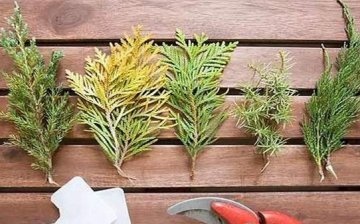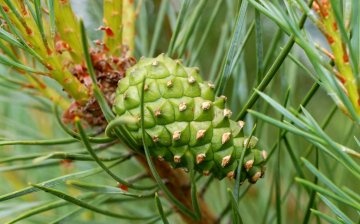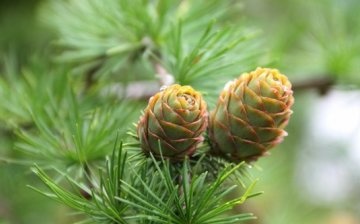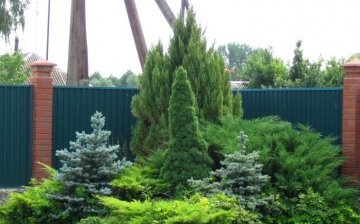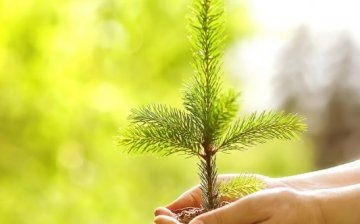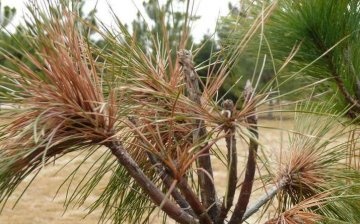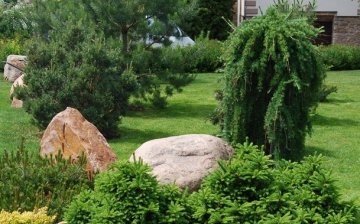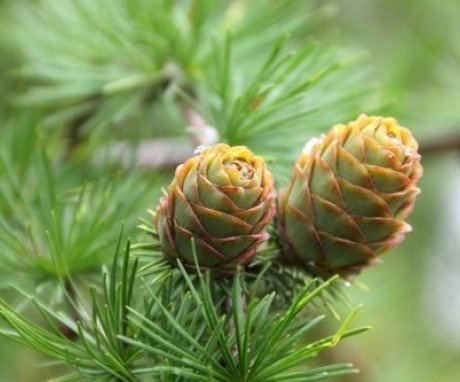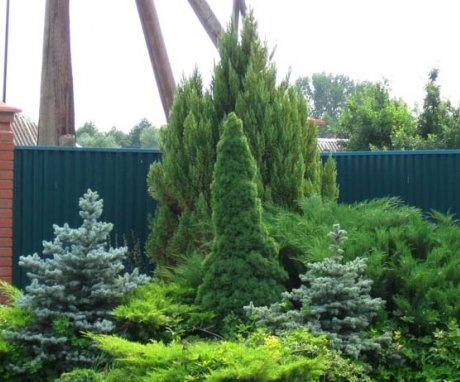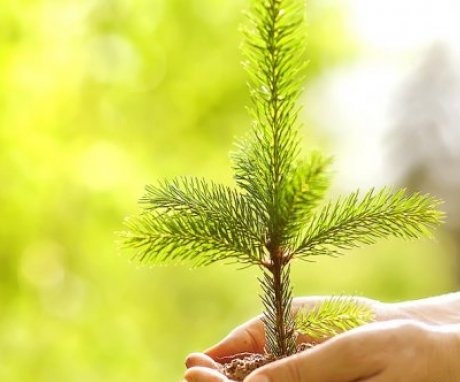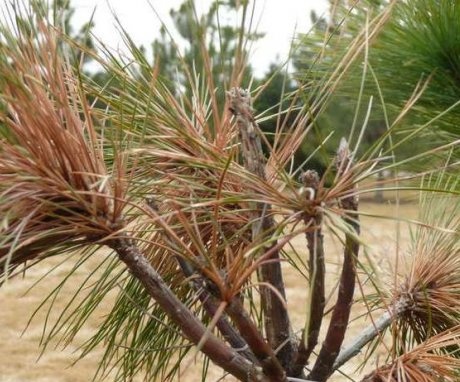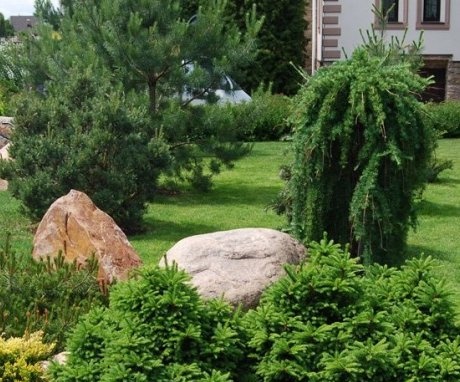Reproduction of pine by cuttings: preparation of the cuttings, planting and care
To decorate the territory, landscape designers often use conifers in their compositions. They look great both in individual plantings and in complex plantings. Due to the fact that conifers are evergreens, the decorative effect of the site remains all year round.
Content:
General information about pine
Pine it is a perennial tree-like plant that belongs to the conifer family. She has a powerful root system, the main root looks like a rod and goes deep into the soil for several meters, long lateral growths extend from it. Some pine varieties can be up to 75 meters high. The trunk is thick, strong, covered with bark, its color can be from gray to yellow-red, sometimes peeling. The branches grow from the main trunk and grow stiff as they grow.
On young sites, needle-like needles grow in bunches from 2 to 5. Each year, the tree forms many cones, which mature in a year and throw out a large number seed.
Pine trees are long-lived trees and can grow for over 350 years.
Thanks to the main root, which goes deep into the ground and can get nutrients for the tree there, the green beauty grows both in fertile lands and in sandy and rocky areas. Only a few species take root in the city, since most of the pine species are highly sensitive to air pollution.
Pine varieties
Popular pine varieties:
- Aristat pine. It is a perennial evergreen tree with a bushy upper part that reaches a height of no more than 15 meters. It is rarely used for decorative purposes to decorate the site, since it requires regular removal of dead needles from the branches. But it looks great in the form bonsai... It has beautiful small buds.
- White pine is mainly found in Japan. It is a perennial evergreen tree with a straight and graceful trunk and few branches, densely covered with long needles. It can reach a height of 20 meters. This variety differs in that the lower part of the needles is colored in a silvery tone. Cones are medium in size, ovoid.
- White pine. This variety is widespread almost throughout Eurasia. White pine forms a low perennial tree up to 10 meters with a wide, dense and spreading crown up to 7 meters in diameter. It is unpretentious to the place of growth and soil and reacts well to smoke and air pollution. Therefore, it can often be found in parks and city gardens.
- Mountain pine grows in the form of a tree; in cultural and ornamental plantations, a multi-stem bush is formed from it. It is unpretentious to the soil, grows well on the Crimean slopes, keeping them from collapses. Often used in ornamental plantings. It is used on an industrial scale in the woodworking industry.
Care
When choosing a pine planting site, several points must be considered. This tree is drought-resistant and does not tolerate waterlogging of the soil.Therefore, it must be planted on well-lit lands with a good drainage system without groundwater running.
Pine is not demanding for the soil composition, but it is desirable that there is a sufficient amount of sand or clay. Front landing it is recommended to check the ground and, if necessary, bring in the required amount when digging.
When preparing the hole, you can lay drainage in the form of pebbles or expanded clay on the bottom, and mix the sod land with clay or sand in proportions of 2: 1.
Basically, all adult specimens of pines tolerate winter and frost well. But young trees with delicate needles are recommended to be insulated for the cold season. To do this, you can use spruce branches or other convenient materials. To prevent diseases from developing in the soil and on trees, it is recommended to regularly remove fallen needles under the trees. This process can be performed 2 times a year or as needed.
Reproduction
The pine tree reproduces with the help of seed, vaccination and cuttings... For the first method, you need to take a ripe cone and get the grains out of it. This can be done by placing it in a paper bag, which in turn is placed in a warm place. Shake the container with the contents periodically. When heated, all the petals of the bud open, and the seeds easily come out of the sinuses.
Before boarding the seeds are treated with stimulants to enhance the germination rate. The process is carried out in the autumn. They are sown in wet sand at a shallow depth, the container is taken out into a cool room. The air temperature is maintained within 1-5 degrees Celsius. This can be a basement or any other cool room.
In the spring, containers are brought into a warm room, and the soil is sifted, taking out seeds.
They are sown again in the prepared loose and light soil, deepening each seed by 2 cm. A greenhouse is made above the crops with the help of glass or film, and the entire container is placed in a bright and warm room. The substrate must be constantly moist, for this it is necessary to periodically water it with a spray bottle with soft water at ambient temperature. When shoots appear, the greenhouse can be removed. To prevent the sprouts from getting sick, it is recommended to treat them with a fungicide solution. Throughout the season, the sprouts are being cared for, the young can only be planted by autumn, and for the winter they can be insulated with spruce branches.
When cuttings, all the characteristics of the mother plant are preserved.
This is one of the most convenient methods for propagating conifers, in which a large amount of starting material can be taken from one tree. But breeding pine trees cuttings are difficult, a small percentage takes root, and with improper care, you can lose all the seedlings.
Pine cuttings:
- Cuttings carried out in the spring, and to obtain the source material, a young tree, grown not in the wild, is selected. Young annual branches are selected that grow upward. The stalk is taken along with the part of the tree to which it is attached, the so-called heel.
- In order for all the resins to come out of the wood, it is recommended to hold the cuttings in water for about 3 hours, and then treat them with disinfectants. To enhance root growth, it is necessary to hold the branches in the stimulating solution for about 12 hours.
- A container with a prepared substrate and drainage at the bottom is preliminarily prepared. The soil should be light and loose; for this, peat is mixed with sand and turf in equal proportions.
- The cuttings are buried 4-5 cm, placing them at a distance of 10 cm from each other.
- After landing, you need to arrange greenhouse and add bottom heating. And if with the first problems basically do not arise, then at home it is quite difficult to organize the correct heating.
- Gardeners recommend placing containers in boxes with semi-rotten compost, manure or ordinary autumn leaves.During the decomposition process, enough temperature is released to provide the cuttings with heat.
- Cuttings are placed in a lighted place, you can root on the street in specially prepared beds, for this, the compost is laid out under drainage.
- After planting, a greenhouse is built.
The rooting period in pine is long, so do not touch the seedlings in the first year after planting. A good root system will grow only by the end of next fall, provided that the cuttings were planted in the spring.
Diseases and pests
Of the diseases of pine trees in decorative plantings, blistering rust or seryanka is most often found. This can be seen by the yellow bloom at the ends of the needles. Such trees are not treated, they are removed from the site and destroyed.
To warn disease, it is necessary for preventive purposes to regularly treat trees with preparations containing copper in the composition.
The most common pests that can attack a tree are aphids and caterpillars. They mainly settle on the edges of young shoots and damage buds and needles. They can be removed with special insecticides by treating all trees and plants that grow nearby.
Application
Pine used in many industries. Its wood has a soft structure, which makes it easy to process it and prepare carved home decorations, furniture and even build houses from it. Also, this tree is often used by landscape designers to decorate an area near a house or make an alpine slide.
Many conifers have medicinal properties. Folk recipes often include young shoots or pine cones. They are used to make tinctures, medicines and lotions.
More information can be found in the video.



